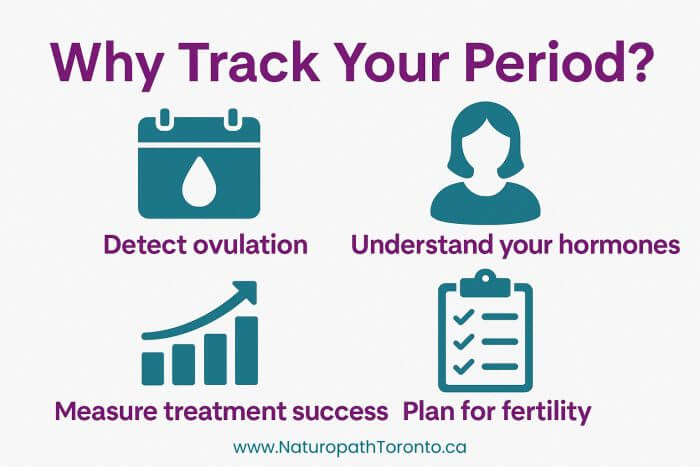Suppose you’ve been diagnosed with Polycystic Ovary Syndrome (PCOS) or suspect you might have it. In that case, period tracking is one of the most important things you can do to understand your hormones, fertility, and overall health. But PCOS can make this feel confusing, especially if your periods are irregular, unpredictable, or even absent. In this post, we’ll explore why tracking is essential, what to track, and how to get started—whether your cycle is clockwork or chaos.
Why Period Tracking Matters with PCOS
PCOS often affects ovulation, which in turn affects menstrual regularity. Period tracking helps you:
1. Identify Patterns (or Lack of Patterns)
Irregular periods are a hallmark of PCOS. By keeping a detailed log, you and your healthcare provider can better understand if and when you’re ovulating, how long your cycles are, and whether your symptoms are improving over time.
2. Spot Warning Signs
Long gaps between periods (more than 35 days) or extremely heavy or painful periods may signal a hormone imbalance, anovulation, or buildup of the uterine lining (which could lead to more serious concerns like endometrial hyperplasia).
3. Support Fertility Goals
If you’re trying to conceive, tracking ovulation along with cervical mucus, basal body temperature, or LH surges can help identify your fertile window and improve the timing of intercourse.
4. Measure Progress with Treatment
Whether you’re using nutritional strategies, supplements, medication, or lifestyle changes, cycle tracking is one of the best ways to measure whether your body is responding positively.
What to Track (It’s More Than Just Your Period)
Here are the most useful things to monitor:
| Symptom or Metric | Why It Matters |
|---|---|
| Cycle length | Helps identify irregular, long, or absent cycles. |
| Bleeding duration | Long or short bleeding may suggest hormone imbalance. |
| Flow intensity | Heavy flow can mean estrogen dominance; very light may suggest no ovulation. |
| Cervical mucus | Changes can indicate fertile days and ovulation. |
| Basal Body Temperature | A sustained temperature rise indicates ovulation has occurred. |
| Ovulation test results | It can correlate with hormone fluctuations, especially if you experience PMS, anxiety, or fatigue. |
| Mood + energy shifts | It can correlate with hormone fluctuations, especially if you experience PMS, anxiety, or fatigue. |
| Acne, hair growth/loss | These symptoms can flare with androgen excess and may fluctuate through your cycle. |
| Cravings or appetite | Long or short bleeding may suggest a hormone imbalance is responsible for cravings, increased or decreased appetite. |
How to Do Period Tracking with PCOS
Period tracking with PCOS can be more challenging than for people with regular cycles, but it’s still very doable. Here are some tools and strategies:
1. Use a Dedicated Period Tracking App
Apps like Clue, Flo, Kindara, Fertility Friend or Natural Cycles allow you to log symptoms and generate useful patterns over time. Choose one that lets you customize for irregular cycles.
2. Use a Paper Tracker or Printable Chart
Sometimes, analog is best—especially if you’re working closely with a naturopathic doctor or fertility specialist. A daily symptom chart allows for detailed notes that can be easily reviewed. Download a free paper tracker below.
3. Track Basal Body Temperature (BBT)
Use a digital thermometer to take your temperature each morning before getting out of bed. A rise in temperature after mid-cycle suggests ovulation has occurred. You do not need an expensive thermometer for this. A normal digital thermometer from any pharmacy will work fine.
4. Observe Cervical Mucus
Fertile mucus is clear, stretchy (like egg whites), and a sign that ovulation may be approaching. If you’re not seeing this type of mucus, it may indicate estrogen is low or not peaking.
5. Ovulation Predictor Kits (OPKs)
LH test strips can help detect your body’s attempt to ovulate, but note: women with PCOS may have false positives due to chronically elevated LH levels. Interpretation should be done with care. It is possible to have a positive LH strip, which indicates that your body is trying to ovulate, but you may not succeed. Basal body temperature charting is more useful to confirm ovulation.
What If You Don’t Get a Period at All?
If your cycles are consistently longer than 45 days or you’re missing periods for months at a time, this is a red flag. It’s important not to wait it out; chronic anovulation can increase your risk for uterine lining issues, including uterine cancer. Work with a healthcare provider to address this, whether through diet and lifestyle interventions or herbal medicine.
Final Thoughts: Make Your Cycle Work for You, Not Against You
With PCOS, your cycle may not follow a textbook 28-day rhythm, but it still holds valuable information. Whether your goal is to reduce symptoms, balance hormones, improve skin, boost energy, or get pregnant, period tracking gives you data that helps guide effective treatment.
If you feel overwhelmed, start small. Just logging the first day of each period is better than nothing. With time, you can build a deeper picture of your hormonal patterns and take empowered steps toward feeling better.
Resources for Getting Started
Get your Free Period Tracking download, guide to understanding your cervical mucus, and PCOS ovulation toolkit here:


